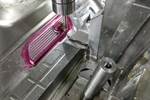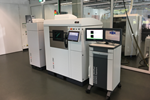Markforged Report Suggests 3D Printing Enabled Manufacturers to Persevere Through COVID-19
Data shows that manufacturers using 3D printing were able to continue normal operations and innovate, while saving time and money.

Photo Credit: Markforged
Markforged (Watertown, Massachusetts), creator of the Digital Forge, what is said to be the world’s largest metal and carbon fiber industrial 3D printing platform, announced on Dec. 3 the findings of its inaugural annual report, “COVID-19 Impact on Supply Chains: Global Additive Manufacturing Industry Report.” In the report, Markforged details how the COVID-19 pandemic impacted manufacturers worldwide, and how 3D printing has helped them to maintain business continuity and grow amid global disruption.
The report also shows that the modern manufacturer—those who adopt digital manufacturing solutions such as 3D printing—were the most resilient, reporting that they’ve been operating “business as usual,” while other manufacturers scaled production back. Key findings include:
- Manufacturers with an industrial 3D printer saved time and money during the pandemic, with 68% indicating that the technology either saved the business “some time” or a “significant amount of time.” Nearly 60% of respondents state that 3D printing has either saved them “some money” or “a significant amount of money.” These time and cost savings not only alleviate immediate, time-sensitive issues for manufacturers, but also result in long-term business value through increased productivity and efficiency.
- Manufacturers that use 3D printing have stayed agile and operational during the pandemic—and found ways to give back. Nearly half (45%) of respondents report that they are operating “business as usual,” and nearly a quarter (24%) have begun producing new products. Survey respondents also report pivoting to print personal protective equipment (PPE). Out of Markforged’s entire customer base, more than 539 used their printers to produce PPE during COVID-19, resulting in more than 5,460 printed parts.
- The pandemic may be a tipping point in manufacturing technology adoption. Many industries are experiencing a forced digital transformation due to pandemic conditions. Manufacturing is no exception, and 3D printing is part of that movement. After seeing the potential of 3D printing over the last several months, 28% of respondents said they are now using 3D printing more compared to pre-pandemic usage. Furthermore, 39% surveyed plan to make future investments in digital manufacturing technologies.
“In an unpredictable world, it’s imperative for organizations to adapt technologies that enable them to remain resilient and flexible ahead of the next disruption,” says Shai Terem, CEO and president, Markforged. “Our research confirms that even during an incredibly uncertain year for manufacturers, those that adopted the Digital Forge have persevered. We’re committed to constantly innovating our industrial 3D printers and software solutions to ensure our customers maintain agility and a competitive advantage, even in the most challenging of times.”
The full industry report is now available for download on Markforged’s website.
Related Content
-
A 3D Printing Retrospective
A personal review of the evolution of 3D printing in moldmaking throughout the past 25 years.
-
The Benefits of Vertically Integrating Metal 3D Printing and Machining
Having 3D printing and machining within one organization enables Addman’s engineers to collaborate and consolidate so it can quickly make successful metal 3D-printed parts.
-
MMT Chats: The Connection Between Additive Manufacturing Education and ROI
This MMT Chat continues the conversation with Action Mold and Machining, as two members of the Additive Manufacturing team dig a little deeper into AM education, AM’s return on investment and the facility and equipment requirements to implement AM properly.











